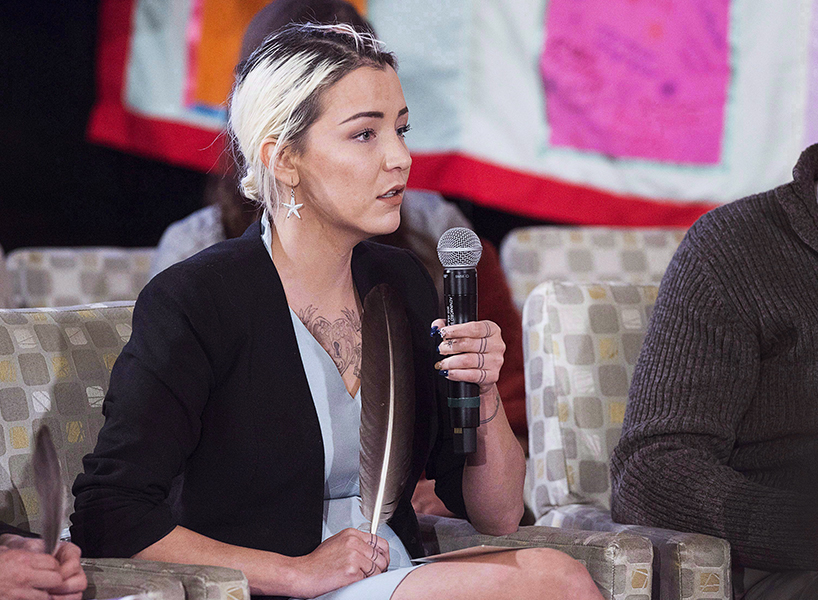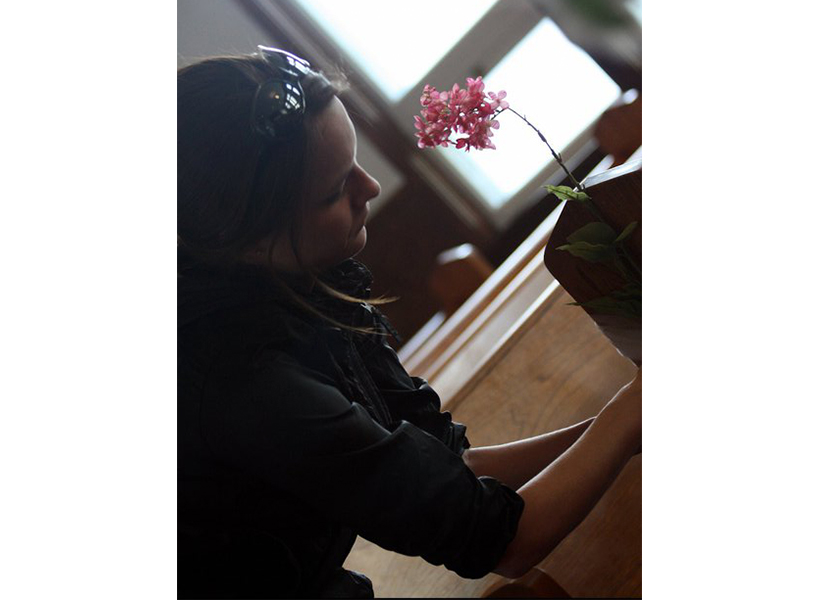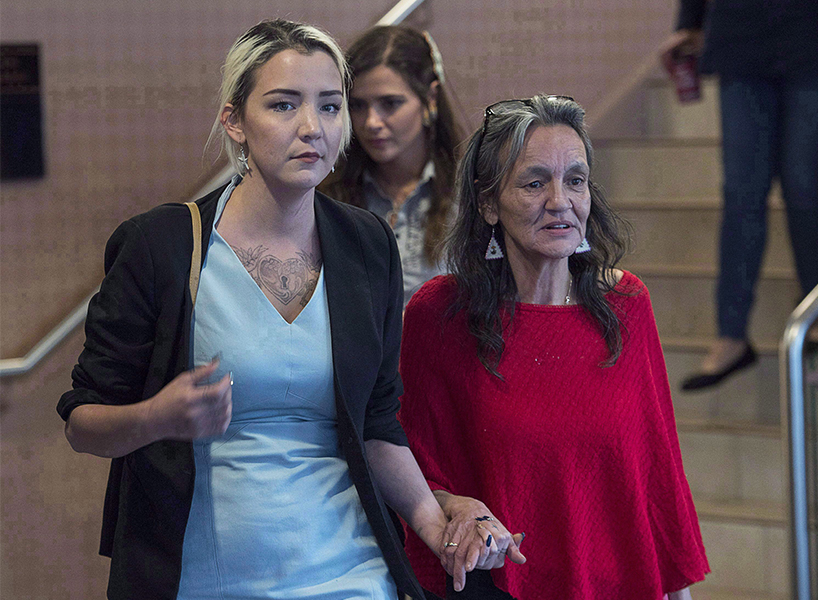The Way We Talk About Tina Fontaine’s Death Reminds Me of My Sister
Delilah Saunders opens up about the loss of her sister Loretta and countless more missing and murdered Indigenous women and girls


By now you’ve heard how the many institutions and systems entrusted to protect us failed Tina Fontaine, the little 15-year-old girl who was found dead on August 17, 2014, in Winnipeg’s Red River, wrapped in a duvet cover, weighed down by rocks. A jury found Raymond Cormier not guilty of second-degree murder. There were tears and audible gasps of disbelief from the crowd in the courtroom. “F-ck you if you think you can get away with this,” Tina’s grieving biological mother, Valentina Duck, said to Cormier just moments after the verdict was read.
On the steps outside the Winnipeg courthouse, Sheila North, Manitoba Keewatinowi Okimakanak Grand Chief, told the crowd: “This is not the outcome anybody wanted. The systems, everything that was involved in Tina’s life, failed her. We’ve all failed her. We as a nation need to do better for our young people.”
She continued: “It might not be this accused person that took her life but someone took her life. That fact remains, and we must get to the bottom of it.”
A lot of people expected this outcome, because our community continues to experience injustice after injustice. But I was trying to stay optimistic.
I remember when I first heard Tina was missing. It was just before what would have been my sister Loretta’s 27th birthday. Loretta was murdered a few months before Tina, in February 2014. You may remember her story. She was killed over a rent cheque: Blake Leggette and Victoria Henneberry were subletting her apartment and she had come to collect the $430 they owed her. Leggette killed her while Henneberry watched. They dumped her in a hockey bag along a highway near Salisbury, N.B. She was 26.
As the trial into Tina’s murder began to unfold in late January of this year, it drummed up a lot of emotions in me. I think it’s because I saw so much of my sister in Tina’s story.
More than a decade before she was murdered, Loretta was living on the streets of Montreal. At 15, she was addicted to drugs and enduring sexual exploitation. She pulled herself out of that situation and began studying at Saint Mary’s University in Halifax. She was a year into researching missing and murdered Indigenous women for her honours thesis in 2014 when she became one.
Had Loretta met the same fate as Tina years earlier—before she had turned her life around—I wonder how the media would have reported on her death. I worry, especially after seeing some headlines about Tina’s murder, that maybe Loretta’s life would have been considered less valuable—and treated accordingly.

We failed Tina before the trial even started
I think back to the one of the first Globe and Mail headlines about the trial—“Tina Fontaine had alcohol, drugs in system when she was killed: toxicologist” (which has since been changed amid outrage for its victim-blaming language)—and it not only upset me because it smeared Tina and her memory, but because I and countless others have long been advocating for change in the way the media reports on missing and murdered Indigenous women and girls.
I’m not the only one who had an issue with the Globe’s headline. It was called out by the Assembly of Manitoba Chiefs as “victim-blaming” and “sensationalistic.” As Grand Chief Arlen Dumas wrote in a letter to the Globe’s editor-in-chief: “It is this type of victim-blaming headline that helps shape the public discourse on the bigger issue of missing and murdered Indigenous women and girls. I can already hear the water-cooler talk: ‘She was drunk, so she had it coming. She was high and with a stranger, what did she expect? Maybe if she wasn’t drunk and high, she’d still be alive.’” Dumas continued: “I recognized the importance of reporting all of the facts, but Tina Fontaine is not the one on trial. It is the Raymond Cormier trial. Why did your newspaper decide to run with a sensationalistic headline?”
Our letter to the @globeandmail editor regarding the headline about #TinaFontaine. pic.twitter.com/bz5kgv6r9T
— AMC (@AMCMBChiefs) 31 January 2018
Dumas is right. Fifteen-year-old girls, whether or not they have trace amounts of drugs or alcohol in their systems, shouldn’t find themselves wrapped in duvet covers weighed down by rocks at bottom of rivers. Nor should we talk about them in ways that perpetuate negative stereotypes of Indigenous peoples.
Yet this is so often what we hear about an Indigenous woman or girl who is missing or found murdered. Reported stories discuss her lifestyle, often labelling it as high-risk. The story might mention sex work or drug use. This narrative is dangerous because it dehumanizes Indigenous women, girls and two-spirited peoples.
I remember speaking at various intermediate and secondary schools in Ontario’s Simcoe County in fall 2017. I told the kids how necessary it is to challenge how we internalize narratives, and how the media frames these narratives, if we want to change the reality of this issue. They got it. I also shared how damaging it is if we use racial slurs, derogatory terms or discriminate in private, even jokingly. An off-handed comment or dirty joke speaks volumes about how we see and treat people. We are constantly consuming media, and although we’ve come far from seeing “dead squaw” in headlines, we still have a long way to go.
We must do more to honour the lives of missing and murdered Indigenous women and girls.

My family and I consider ourselves “lucky”
The initial coverage of Tina’s murder trial reminded me how the media and the judicial system have continued to fail families, survivors and victims. We see this happen time and again in the narratives put forward and the insignificant sentences (or negotiated plea deals) so often delivered in court.
Only a few weeks prior to Loretta’s death, I was hitchhiking across Vancouver Island. My sister was my guardian and best friend since birth, and she was livid about what I was doing. She would tell me: “It’s not just one Native girl going missing—it’s being declared a national epidemic.” At the time, I didn’t realize how much danger I put myself in, even after hopping into stranger’s cars. It only hit me when calls and messages from family and friends flooded in and we realized Loretta was missing.
My family and I consider ourselves “lucky” in comparison to many families of Indigenous women, girls and two-spirited people who have lost loved ones. We were able to hold two people accountable for taking her life. The Nova Scotia judge who sentenced her two killers to life in prison called their actions “despicable, horrifying and cowardly.” We are lucky because we were able to lay my sister to rest and receive answers surrounding her death.
Not everyone gets that chance. Some families have been waiting decades to share their loved one’s story or have their pleas taken seriously in an official capacity. We must recognize and honour the nearly 1,200 families and survivors for volunteering their time and testimonies for the National Inquiry into Missing and Murdered Indigenous Women and Girls. For many, participating in the Inquiry may be the closest thing they will have to experiencing justice.
We know that Indigenous women and girls in Canada report rates of violence, including domestic abuse and sexual assault, up to 3.5 times higher than non-Indigenous women. Right now, the Inquiry is still in the process of its truth-gathering phase, the goal of which is to allow people to share their stories, through community and institutional hearings, expert panels and even in poetry, song and artwork. A report is due at the end of this year, which we’re told will outline specific recommendations for concrete and effective action to be taken to remove the systemic causes of violence against Indigenous women, girls and the LGBTQ+ community.
The Inquiry is long overdue, but there has been widespread criticism over the way it has been structured—even from those within it, like Marilyn Poitras, a commissioner who resigned just 10 months after assuming her post. When asked if she felt the Inquiry was “doomed to fail,” Poitras told the CBC that she didn’t think it was “going to get at the roots of systemic violence” based on the way it was currently modelled. And we desperately need it to get at those roots.
The key issues, as I see them, are lack of action and support. There’s not enough of a national focus on the stories shared by Indigenous women and girls and their families. And I’m not alone in feeling this way. Even Poitras stated the importance of these stories.
Since the Inquiry began, I had made it my top priority to be present and get involved. My studies suffered, and so did my health. My family and I testified at the Inquiry publicly on October 30, 2017. The experience of sharing my story about my sister’s death and the impact it had on me was traumatic. Following my testimony, I wasn’t provided timely aftercare from a member of a health team, as I thought I would. I had been open about my struggles with alcohol with the Inquiry staff. After five months of continuous sobriety, I relapsed shortly after sharing my testimony.
My story made headlines in December, when I was admitted to a hospital in Ottawa with acute liver failure brought on by taking Tylenol. My friends and family advocated for me to be seen in a hospital in Toronto. I was in critical condition, but I was denied a spot on the transplant waiting list or the chance to receive live donor tissue because I was told I hadn’t remained sober for the previous six months. To me, and many others, the six-month sobriety rule feels outdated and discriminatory. As I told the CBC, the policy is damning someone who already has a disease.
Here’s the thing: I knew I needed help and I asked for it, but I wasn’t given aftercare when I needed it most. Shortly after my story broke, an upscale treatment centre reached out to me back in December to offer me free, holistic treatment. I asked the Inquiry to help cover my travel costs, and I was told, day after day, that they would let me know if they could do it. I waited and called, called and waited. Weeks turned into months. My travel request to go to a treatment centre was only just approved this month, four months after I spoke before the Inquiry.

How I’m carrying on Loretta and Tina’s legacy
There are so many things about this whole process for justice that have affected me and my loved ones. Still I want to continue stressing the fact that the words we choose when we write about the missing and murdered are important.
In Indigenous cultures, telling stories is a powerful way to build community. They carry meaning and knowledge, and communicate ways of knowing, of being. We understand the importance of stories—specifically how you tell and share them. Often, in our communities, a person will be asked where they received a story and if they have been given permission to share that story. Stories are sacred, and they have a profound effect on listeners.
If the stories of missing and murdered Indigenous women and girls were treated more respectfully—like what Loretta was doing with her research, and what so many other people are doing within our communities—I wonder what the far-reaching impact might be toward ending the systemic discrimination against Indigenous peoples.
A deep pain and grief is felt collectively throughout the country following the verdict delivered in the trial against Raymond Cormier. #LoveForTina marches and rallies gave us an opportunity to hold ceremony, pray and share our experiences. It also gave us a chance to stand up against the many systems that failed Tina and continue to fail Indigenous peoples. While we collectively feel the loss and injustice, we are collectively standing together to demand justice and a better fate than the colonial system has designed for Indigenous peoples.
Loretta often spoke about how she wanted to use her research to break the cycle—for me and other Indigenous women and girls. I keep my sister alive through my activism. I also keep her alive by living my best life and continuing to strive to be the best person I can be. I owe it to her to keep on this path.
—With files from Naomi Sayers








